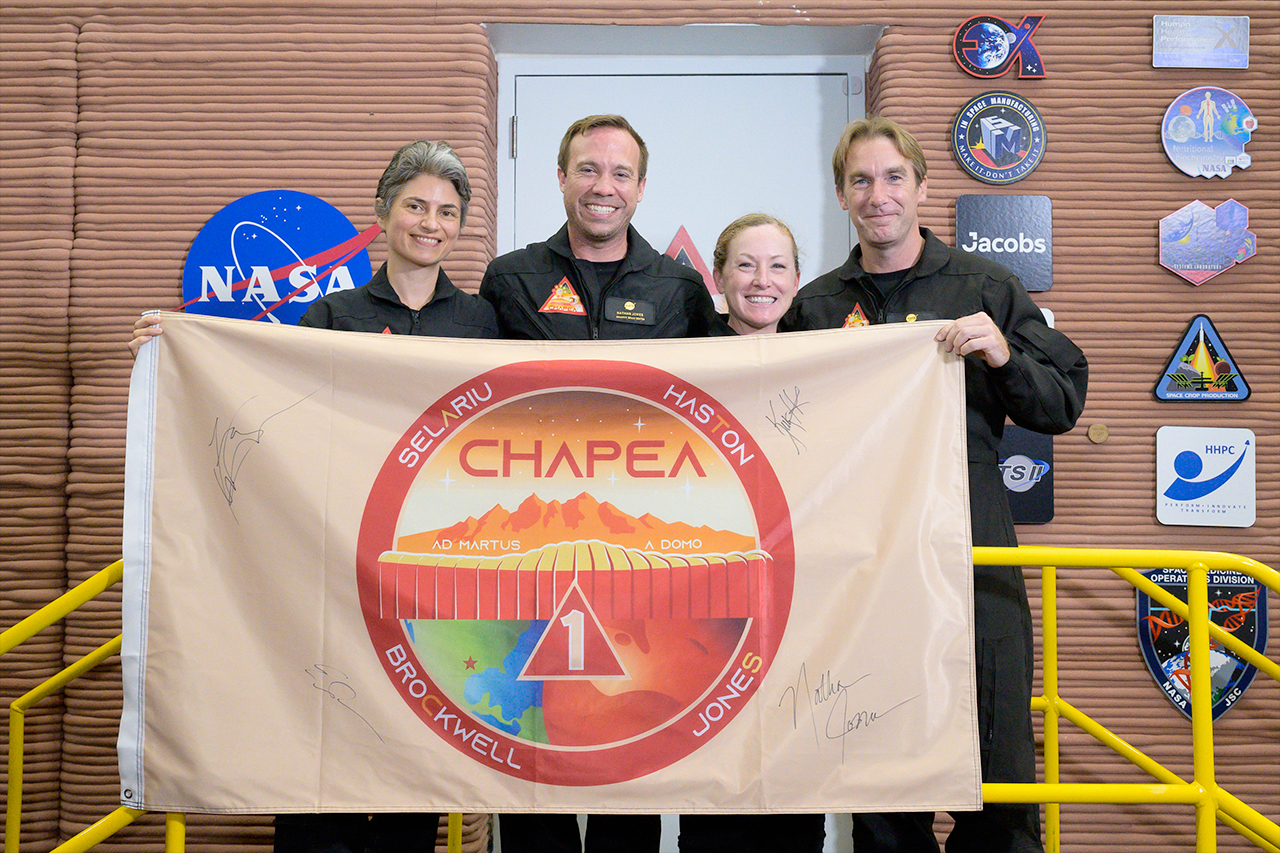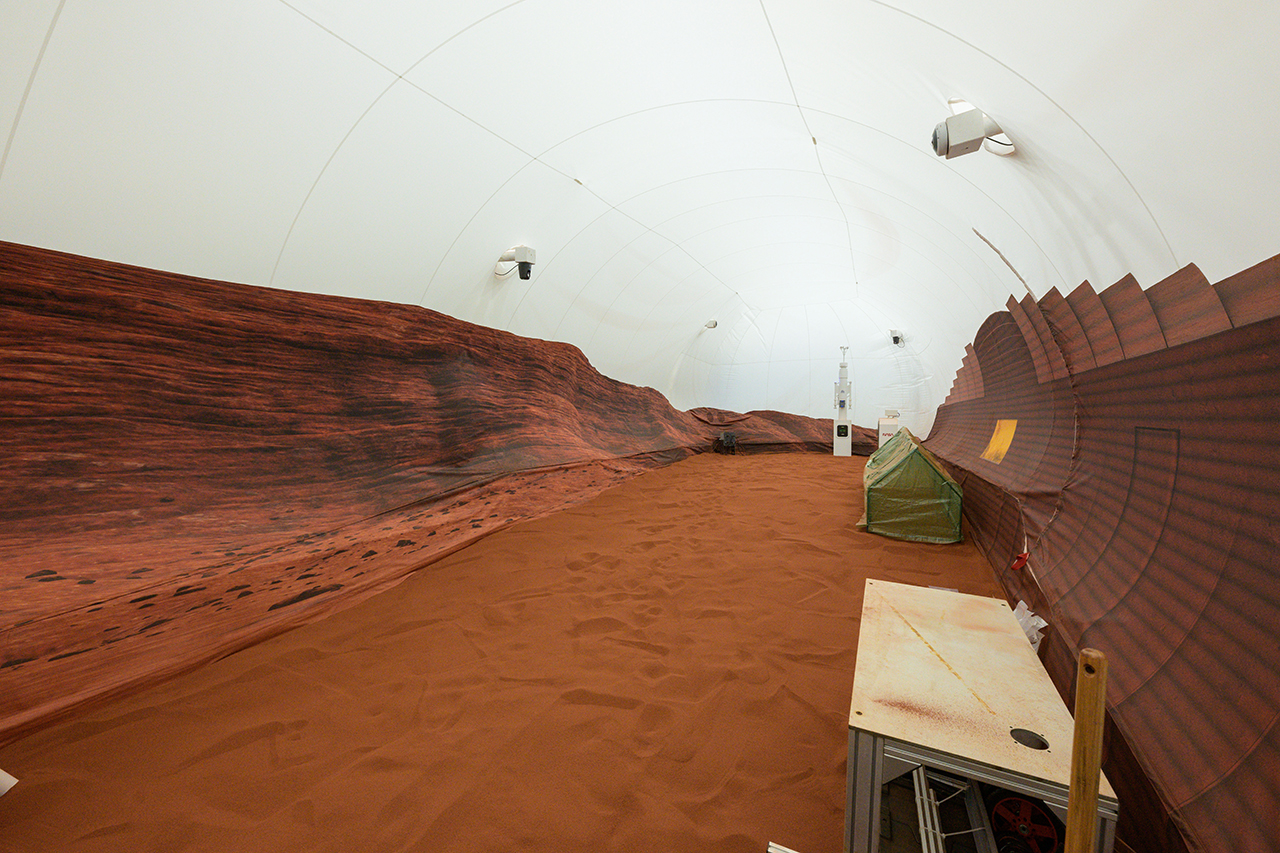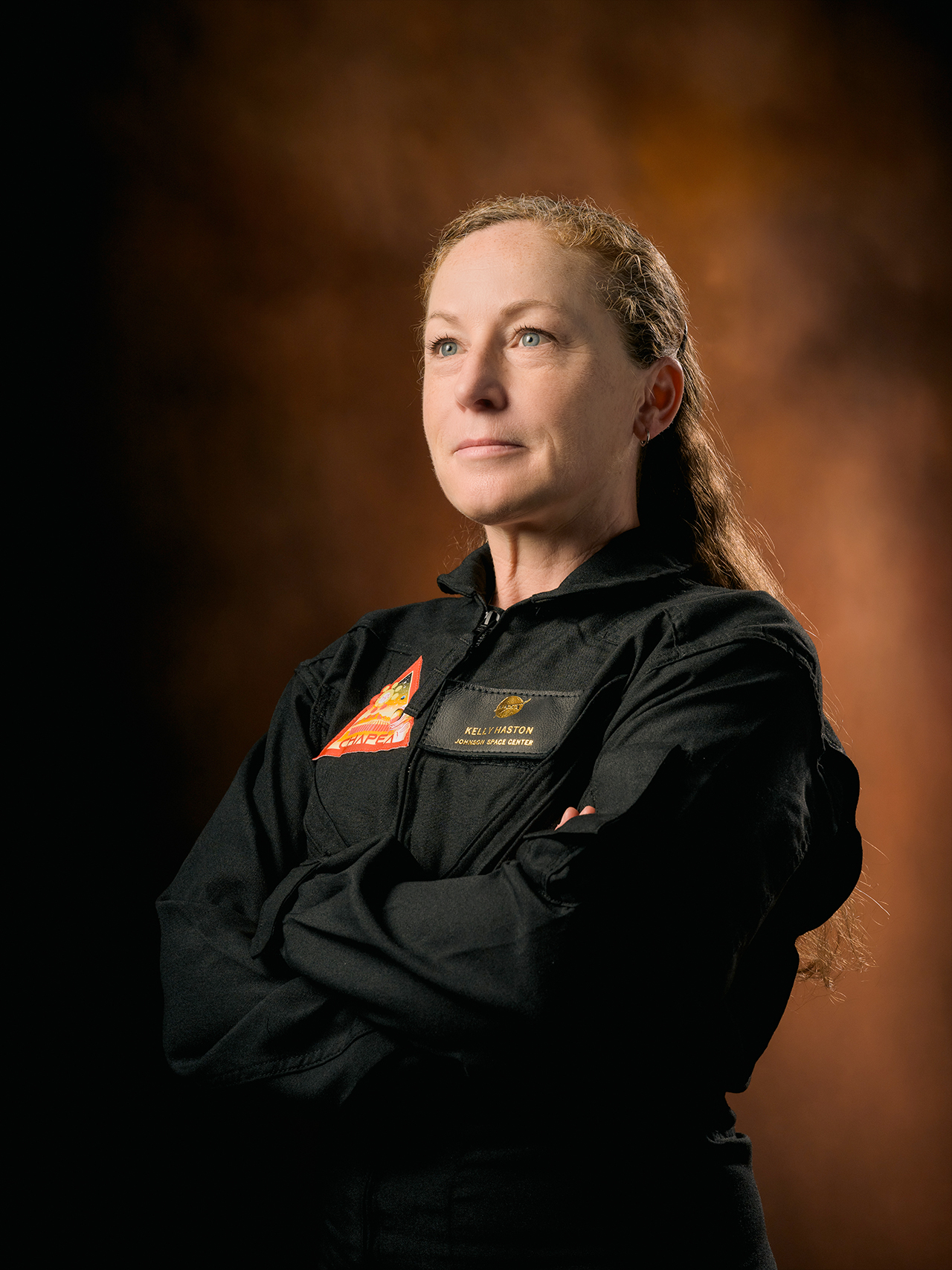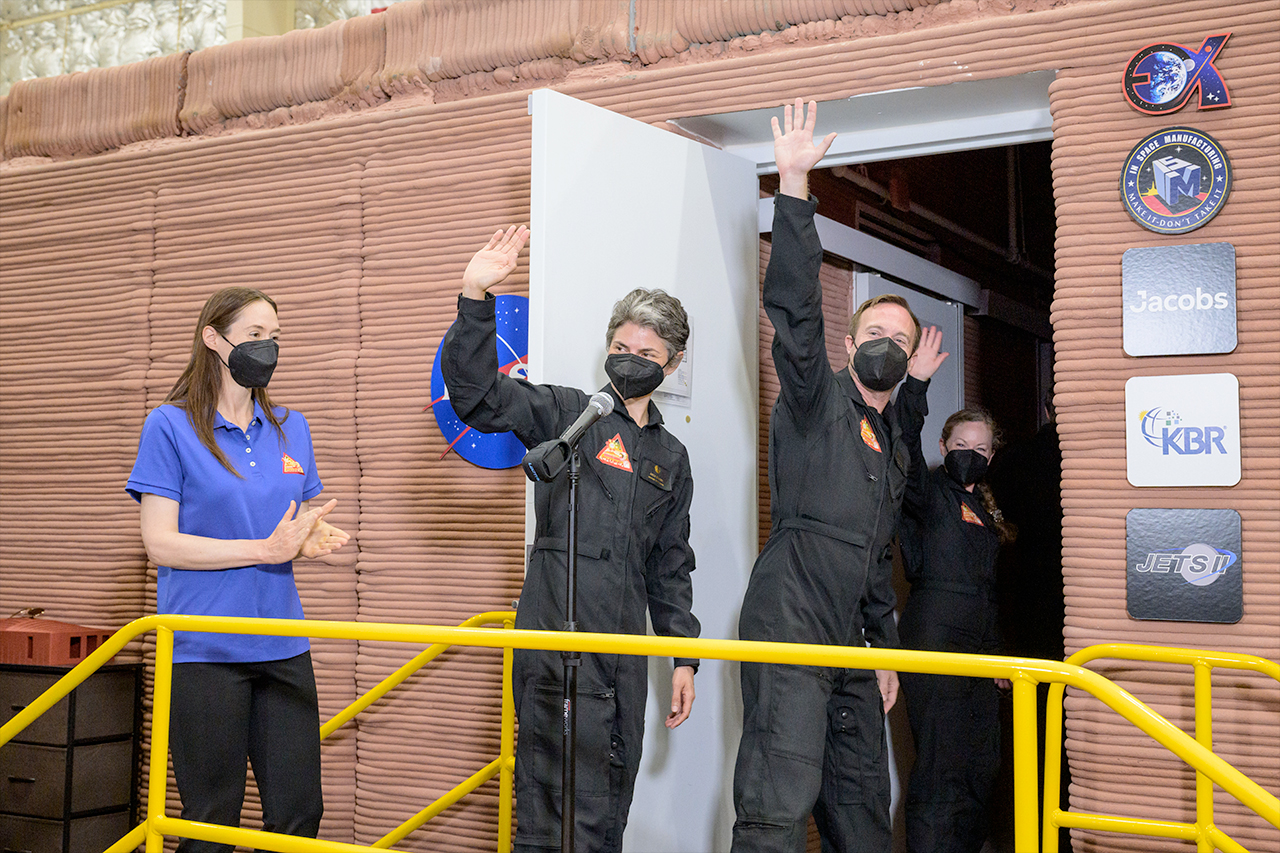Life on 'Mars:' Commander of NASA's 1st yearlong analog comments on 1st month, food and stars
'The daily challenge of being on Mars has so far been very fun.'

It's been a full month since Kelly Haston moved to Mars.
As commander of NASA's first CHAPEA (Crew Health and Performance Exploration Analog) mission, Haston and her three crewmates volunteered to live for more than a year secluded inside "Mars Dune Alpha," a 1,700-square-foot (158 square meters) Mars base-like habitat that is located not on the Red Planet, but rather at the Johnson Space Center in Houston.
As Haston and her crew — flight engineer Ross Brockwell, medical officer Nathan Jones and science officer Anca Selariu — simulate life on Mars, a team of scientists "back on Earth" are monitoring the crew's ability to complete tasks and work through the types of stresses astronauts might encounter to better prepare for sending astronauts to Mars in the future.
To keep conditions as close to real as possible, communications with the CHAPEA crew are on limited to the same transit times it would take a signal to pass between Earth and Mars. As such, video or phone interviews are not possible. With the help of CHAPEA mission control, though, collectSPACE.com was able to interview Haston via email to learn what life inside Mars Dune Alpha has been like during her first 30 days.
Related: 1 year on 'Mars:' NASA analog astronauts begin mock Red Planet mission
collectSPACE (cS): Thinking back to June 25 and your first day in the habitat, can you recount your first 24 hours inside?
Kelly Haston: We were so happy upon ingress to the habitat that as soon as we got through the door and it closed, we formed a spontaneous group hug and let out a big cheer. It made the crowd watching the ingress laugh, and then we heard them cheer for us. It was very a special moment.
Breaking space news, the latest updates on rocket launches, skywatching events and more!
That first night we spent time unpacking our gear and setting up our bedrooms, then we had a celebratory hot chocolate.
The next day we had a full day of tasks set up for us. Our activities are tracked using an interactive app that provided prompts and document links to the things we are scheduled to do. This both helps keep us on schedule and also lets mission control know that we have completed tasks. When there are problems or changes to the schedule, we alert mission control of these in the mission log. Due to the time delay, we have learned to be prepared ahead of time, as if you figure out something is wrong, or missing, at the start of a task, it will take over 30 minutes for that to be communicated to mission control and for us to hear back with a solution. This means we are often troubleshooting issues on our own while waiting for mission control to get back to us with additional information.
We also have specified exercise that we complete and document on days when we are not leaving the habitat to do work on the Martian surface. Additionally, we document all food and liquids we ingest. On our first day we did all of those things but also took the opportunity to inventory the items in the habitat, as it was important for us to know where everything is, but also to make sure that the items we thought were sent with us were indeed present and report discrepancies to mission control.
cS: How long was it before the initial excitement of a new experience wore off — if, indeed, it has — and you settled into a routine?
Haston: I am not sure that the initial excitement has fully worn off; we are still often doing new things each week and learning a great deal. However, the team works really well together, and we dropped into daily schedule and work norms fairly quickly, so I think we had a routine fairly quickly, and by the second week we felt fairly good about the schedule and completing our daily mission goals in an efficient manner.
Related: The 9 coolest mock space missions
cS: What is a typical day for you now? Can you give us a brief "day-in-the-life" of an analog Mars mission crew member?
Haston: A day in the life is a hard one; as mentioned previously, we have a fair bit of variety. I will give an example from a day that we go out onto the Martian surface. We call these EVAs or extravehicular activities where we go, we go outside the habitat and walk around on "Mars" and perform different task that you would expect are needed to keep a Martian base running and sometimes utilize virtual reality, which is really fun and very beautiful.
We start the day around 06:00 by weighing ourselves right after we get up, as the scientists running the simulation want to collect as much data as possible and also make sure we are staying healthy. After getting cleaned up we have breakfast and tag up, discussing the coming day's tasks and needs, and answering any outstanding queries from the day before. This is a chance to change the schedule if needed or make sure all things are covered and that everyone knows their role for the day.
Then we do a quick pre-brief for the EVA, although often we have discussed this the night before as well. Following the pre-brief, the team that is performing the EVA exits the habitat and starts to move through a series of airlocks and procedures that will eventually have them stepping onto Mars in their simulated spacesuits, with any tools required for the day's goals.
The two crew left inside will trade off being the mission control giving directions to the EVA crew, as well as getting their daily exercise and any other inside tasks completed. When troubleshooting is required, the inside crew will often combine forces to ensure we move through the issue as quickly as possible to enable the EVA crew to complete their goals in the allotted time.
When they come back in there is time to get cleaned up, because it is often quite sweaty, hard work, and the suit and gear are big and heavy, and then we do a de-brief where the crew discusses what went well and possible improvements or alternative approaches for next time. Sometimes we also do surveys or testing after EVAs that are part of the data collection for the project.
We then do any additional tasks or maintenance the habitat requires, eat dinner, and then have personal time, as well as some time to write in our journals. In general, we are lights out by ~22:00, to get enough rest to do it all again the next day.
cS: What have you found to be the biggest challenge so far?
Haston: The biggest challenge so far is communication with our loved ones and family. The time delay and data restrictions mean that things can get held up unexpectedly, or be slower than expected, if a lot of different items are queued up at the same time. We have worked through several unexpected challenges in this regard, so it's been a steeper learning curve that I thought we would need.
Happily, that is the major challenge we have faced so far, and we hope it is getting better. The daily challenge of being on Mars has so far been very fun.
Related: What would it be like to live on Mars?
cS: Are you keeping a calendar? Drawing hashmarks on the wall to count until your 378 days are complete? Or are you trying to ignore the passage of time?
Haston: I would not say I am keeping a calendar, but my partner in California really wanted us to count up, not down, so we mark the passage of time with how many days have passed, not how many we have left. So far it has felt pretty good to approach it that way, but I feel like I mark the weeks more than the days.
cS: How is the food? Are you limited to freeze-dried or thermostabilized meals, or do you have access to any fresh food (i.e. from a garden)?
Haston: The food is actually really good and is mainly a mix of freeze-dried and MRE [Meals Ready to Eat]/thermostabilized. However, once a week we get a special meal and that mixes it up a bit and gives us some special flavors to add variety to the standard items. However, we do actually have a lot of variety in our daily food selections, more than I expected.
We document everything we eat and drink, even shakes of salt or pepper, so each meal tends to have a lot of discussion over the merits of a given item, what values it gets you for calories or proteins or other needed nutrients. I don't think many favorites have popped out yet and right now everyone is getting a good mix of things to eat.
cS: How is the crew dynamic? You had a late swap of crewmates. Did that have any effect on your ability to get along in the hab?
Selariu was at first selected to be a backup crew member, but replaced Alyssa Shannon prior to the mission starting. NASA did not provide an explanation for the change.
Haston: The crew dynamic has been really fantastic from the start of my involvement in this project, even during evaluation periods. I was amazed by how natural and comfortable I was with everyone and how caring they were about wanting to get to know me and be part of a team.
And that is the great thing about our crew. We entered training as a team, whether you were a backup or not; we never thought of each member as different, and when we did have a late swap, it meant we were already used to functioning as a team, there was no awkwardness or need to adapt to a new configuration. We were sad for our crew that would not be coming, but in terms of crew function we are doing great.
cS: On the International Space Station, NASA has found that arranging periodic contacts with the crew members' favorite celebrities can help psychologically. Has NASA offered the same to you and your crew? Have you had any interesting interactions thus far (even given the comms delay)?
Haston: We have not had this suggested yet, although it does sound like a fun idea. It would have to be a video, so perhaps it has not been suggested due to the lack of ability to be interactive, due to data limitations when you are on "Mars."
Despite that limitation I would love if we got surprises like this during the mission! It would also be helpful to hear from the astronauts as well, maybe more than famous people, and I would guess the crew would like that best.
cS: What do you think the biggest difference between your experience and a crew actually on Mars would be in terms of the experience living in a confined hab?
Haston: The first obvious difference is that we are not actually experiencing lower gravity or differences in oxygen. This would not be possible to simulate but would be physiologically very different, and also make EVAs a lot more dangerous if something goes wrong.
The other main difference would be that they would be gone for much longer, possibly over three years due to travel constraints, and also that the likelihood of return is obviously not quite as secure as during an analog. Knowing that we will egress in just a little over a year and that we will definitely egress from this mission is a lot less stressful than someone actually traveling to and living on Mars.
cS: Do you have access to tape-delayed TV or news programming? Any chance your crew is watching "Stars on Mars" and if so, what you do think of the "celebronauts" experience compared to your own thus far?
"Star on Mars" is a reality show airing on Fox that, like CHAPEA, has brought together a group of people — in the show's case, celebrities — to undertake the challenges of living in a simulated Mars base. The show is made for entertainment, so while there are some similarities to the CHAPEA mission, there is no science aspect to "Stars on Mars."
Haston: The crew got to bring a certain amount of personal data with us, and we did a good job of collaborating on the content, so we have a lot of movies and shows to watch, but currently we prefer to use our limited data bandwidth to focus on communicating with your family and friends, rather than ask for any new items.
Some of my friends have told me about this show, but I have not yet seen it. However, I do love [former NFL football player and "Stars on Mars" celebronaut] Marshawn Lynch, so I am hoping he will win it (please don't tell me if he is already off the show!).
It is hard to say how our experiences are different having not seen it, but we think a lot about the data we are helping to produce, and how to do the best job producing it, but not about entertaining people, although I am sure some of the things that we are doing or will happen to us will be pretty funny in the long run.
Follow collectSPACE.com on Facebook and on Twitter at @collectSPACE. Copyright 2023 collectSPACE.com. All rights reserved.

Robert Pearlman is a space historian, journalist and the founder and editor of collectSPACE.com, a daily news publication and community devoted to space history with a particular focus on how and where space exploration intersects with pop culture. Pearlman is also a contributing writer for Space.com and co-author of "Space Stations: The Art, Science, and Reality of Working in Space” published by Smithsonian Books in 2018.
In 2009, he was inducted into the U.S. Space Camp Hall of Fame in Huntsville, Alabama. In 2021, he was honored by the American Astronautical Society with the Ordway Award for Sustained Excellence in Spaceflight History. In 2023, the National Space Club Florida Committee recognized Pearlman with the Kolcum News and Communications Award for excellence in telling the space story along the Space Coast and throughout the world.





